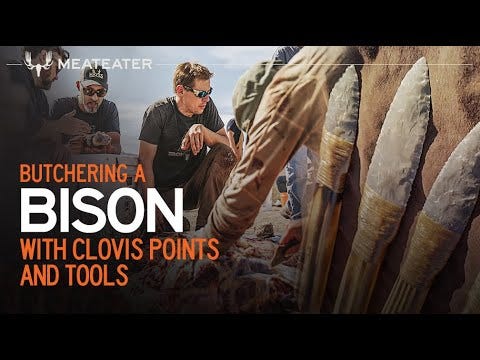Knives of the Ancients
I've always loved imagining how prehistoric people lived, made things and ate. I like it so much that, after college, I learned how to make stone tools, braintan animal hides and make rope directly from plants and tree bark.
In this fascinating video, experimental archeologists at Kent State University teamed up with hunter and author Steve Rinella and his team at Meateater to butcher an entire bison with Ice Age stone tool technology. This fascinating experiment gave insight into the lives and strategies of ancient peoples. Besides feeding the prehistoric imagination of obsessives like me, this kind of experiment helps archeologists better interpret what they find in the ground - different kinds of stone tools leave specific marks on animal's bones during the butchering process, and, having watched those marks being made in real-time, the archeologists can better imagine what techniques and tools ancient hunters were using when they analyze bones.
Here are photos of the two kinds of tools used:


For starters, this video illustrates well that butchers must have the anatomy knowledge of orthopedic surgeons. And the duller the cutting edge, the better your anatomical knowledge has to be. The same goes for the absence of a saw.
It seems that the stone flakes worked better in the video than the more complicated biface knives. This is convenient for ancient peoples, since the flakes are much quicker to make - basically one bash of a rock and you have a flake. As opposed to the biface knives which take more time and intricate flintknapping, and then must be attached to a wooden handle with glue and sinew wrapping. The edges of these stone flakes are actually sharper than a surgeon's scalpel - broken rock, like broken glass, creates a sharper edge than grinding a piece of steel.
This video also demonstrates that there was likely a division of labor at prehistoric megafauna kill sites. Standing beside a large dead animal was a dangerous place to be, since predators and scavengers were always lurking. Some people would have done the actual butchering while others sharpened stone stools and made new ones that they continuously fed to the butchers as tools broke or dulled. At the same time, others probably served as watchmen to look out for dangerous incoming animals. This division was key to being quick and efficient about it. Maybe others even started fires and cooked right there. This is just like the division of labor around some meals today - there are those who cook the food, those who serve it, those who eat it, and those who clean up after it.
In the book "The Evolution of Obesity," the authors theorize (as have others) that eating communal meals was a big step forward for early humans. There is a survival advantage in eating meals in groups - there is safety in numbers, since predators and scavengers are always lurking just beyond the campfire's glow (and in the Ice Age, those animals were gigantic). But communal meals also helped develop our sense of sharing and a delayed gratification, since the food had to be carried back to camp, rather than consumed right on the spot. The development of food processing techniques like cooking, grinding and drying also probably promoted this communal food behavior.
One other detail: in many cultures, this butchering was the women's work (the men having done the killing). It would have been interesting to include a few women in this project and measure for differences in wear on the stone tools. Though I don’t think it makes a huge difference in the ultimate outcome. And besides, prehistoric women were probably as strong as, or stronger than, men today.
I’d love to hear your comments and thoughts on this endlessly fascinating topic.



